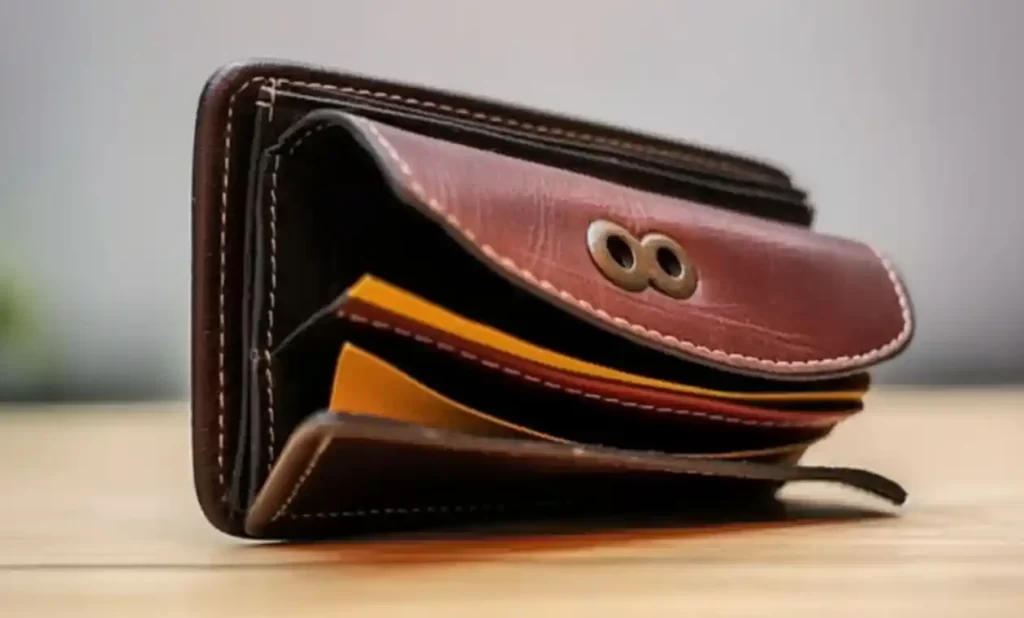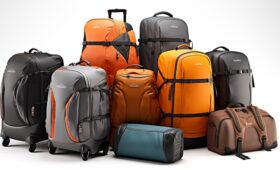
In an age where technology and travel intersect, ensuring the safety of your personal and financial information has become paramount. As you embark on your adventures, be it a leisurely vacation or a business trip, the need to safeguard your belongings from digital theft and physical pickpockets cannot be overstated. This article delves into the world of travel security and explores the critical tools at your disposal: RFID-blocking wallets and anti-theft bags.
In an increasingly digital world, your personal and financial information is stored on various cards and documents, many of which are embedded with RFID (Radio-Frequency Identification) chips. These chips make transactions and identity verification convenient but also expose your data to potential theft.
Herein lies the importance of RFID-blocking wallets, which act as digital shields to safeguard your information from unauthorized scanning. They offer peace of mind, ensuring that your financial details remain private, even in the midst of bustling airports or crowded tourist destinations.
As important as it is to shield your digital identity, safeguarding your physical possessions is equally crucial. Anti-theft bags are designed to thwart the craftiest of pickpockets and bag snatchers. These bags come equipped with ingenious security features such as locking zippers, cut-resistant straps, and hidden pockets, making them a formidable barrier against theft.
In this article, we explore the need for luggage safety during travel and provide valuable insights into RFID-blocking wallets and anti-theft bags. Discover the technologies and features that protect you from identity theft and pickpocketing, and learn how to select the ideal RFID-blocking wallet or anti-theft bag for your travel needs.
With these tools in hand, you can roam the world with confidence, knowing that your information and belongings are secure. Travel smarter, travel safer.
The Rising Concern: Identity and Bag Theft
As the world becomes increasingly interconnected and reliant on technology, the concern of identity theft and bag theft during travel has grown exponentially. Travelers, whether jetting off for a vacation or a business trip, are at greater risk than ever before. Here’s why:
- The Threat of Identity Theft: In today’s digital age, personal and financial information is often stored on credit cards, passports, and other documents embedded with RFID (Radio-Frequency Identification) chips. These chips simplify various aspects of travel, from contactless payments to swift passport scanning.
However, this convenience also exposes travelers to the risk of identity theft. Cybercriminals with RFID scanners can potentially intercept and misuse this data, causing financial loss and personal distress.
- The Perils of Bag Theft: Traditional bags, even the most well-designed and sturdy ones, remain vulnerable to skilled pickpockets. Opportunistic thieves can exploit crowded airports, bustling tourist destinations, and other crowded areas, making off with your belongings in the blink of an eye. Whether it’s your wallet, passport, camera, or even a cherished souvenir, the loss of essential items can disrupt your travel plans and tarnish your experience.
RFID Technology and Bag Vulnerability
RFID-blocking wallets and anti-theft bags are direct responses to these pressing issues. The advent of RFID technology, while immensely convenient, has raised valid concerns about data security during travel. Traditional bags, despite their evolution in design and materials, still struggle to provide comprehensive protection against determined thieves.
In the sections that follow, we will delve deeper into these concerns and explore the effectiveness of RFID-blocking wallets and anti-theft bags in countering these threats. By understanding the risks, you can make informed decisions about how best to protect your personal and financial information, as well as your cherished travel possessions.
Understanding RFID-blocking Wallets
RFID, which stands for Radio-Frequency Identification, is a technology that employs electromagnetic fields to identify and track tags attached to objects, including credit cards, passports, and even some driver’s licenses.
This technology has revolutionized various industries by offering an efficient and convenient means of data transfer. In the realm of travel, RFID is widely used to simplify processes such as contactless payments, electronic boarding passes, and passport scanning.
The Vulnerabilities of RFID: However, the same convenience that RFID offers also brings about vulnerabilities. Criminals equipped with RFID scanners can intercept and read the data transmitted by these tags, potentially compromising sensitive personal and financial information.
The Shielding Power of RFID-Blocking Wallets
RFID-blocking wallets are specially designed to counteract this threat. They contain a protective lining composed of materials like metal or conductive fabric. When you place your RFID-enabled cards and documents inside these wallets, the lining creates a Faraday cage effect. This means it forms a shield that blocks electromagnetic fields, preventing RFID scanners from intercepting the data.
Benefits of RFID-Blocking Wallets
- Data Protection: The most significant benefit of RFID-blocking wallets is the safeguarding of your personal and financial information. When you’re on the go, you can rest assured that your data remains secure within the wallet.
- Peace of Mind: Knowing that your sensitive information is protected contributes to a stress-free and enjoyable travel experience. You won’t have to worry about data theft while exploring new destinations.
- Ease of Use: These wallets are designed for convenience. They often feature multiple card slots, compartments for cash, and clear ID windows, ensuring you can carry your essential items without sacrificing functionality.
- Wide Variety: RFID-blocking wallets come in various styles, from sleek leather designs for business travelers to compact, minimalist options for backpackers. This diversity means you can find a wallet that suits your travel needs and style preferences.
In the following sections, we will explore the world of anti-theft bags and how they complement the security offered by RFID-blocking wallets. Together, these two elements form a robust defense against both digital and physical threats to your belongings during travel.
Advanced Features and Technologies
Anti-theft bags are designed with a myriad of features and technologies to safeguard your belongings. These innovative elements make them an indispensable addition to your travel gear:
- Lockable Zippers: Anti-theft bags are equipped with lockable zippers, which allow you to secure your bag’s compartments with a padlock. This feature makes it challenging for pickpockets to access the contents of your bag discreetly.
- Cut-Resistant Straps and Panels: The straps and panels of anti-theft bags are often reinforced with cut-resistant materials like stainless steel mesh. This deters thieves from attempting to slash the bag open to steal your valuables.
- Hidden Pockets: Anti-theft bags incorporate hidden pockets and compartments where you can discreetly stow your most valuable items, such as passports, smartphones, and wallets.
- RFID-Blocking Pockets: Some anti-theft bags include RFID-blocking pockets. These are particularly useful for protecting your credit cards, passports, and other RFID-enabled documents from electronic pickpocketing.
- Locking Cable Mechanisms: Certain anti-theft bags have locking cable mechanisms that allow you to secure your bag to a stationary object, like a table or chair, when you’re in a public place. This adds an extra layer of protection against bag snatchers.
Deterring Pickpockets and Thieves
Anti-theft bags act as formidable deterrents to pickpockets and thieves:
- Visible Security Measures: The presence of lockable zippers, cut-resistant straps, and other security features sends a clear message to potential thieves that your bag is not an easy target.
- Challenging Accessibility: These bags are designed to make it time-consuming and difficult for thieves to access the contents. The more time and effort it takes, the higher the chances of getting caught, discouraging theft attempts.
- Hidden Valuables: Concealed pockets and compartments make it challenging for pickpockets to identify and access your most valuable items.
- Peace of Mind: Carrying an anti-theft bag allows you to enjoy your travels with peace of mind. You won’t constantly worry about the safety of your belongings, making your journey more enjoyable.
Advantages of Investing in Anti-Theft Bags
- Enhanced Security: The primary advantage of using anti-theft bags is the heightened security they provide for your belongings. This security extends not only to your valuable items but also to your entire travel experience.
- Improved Travel Confidence: Knowing that you’re taking proactive steps to protect your possessions boosts your confidence and allows you to immerse yourself in your travel experiences.
- Durability and Longevity: Anti-theft bags are often constructed with durability in mind, ensuring they last for multiple trips. This means your investment pays off in the long run.
- Style and Versatility: These bags come in various styles and designs, ensuring you don’t have to sacrifice aesthetics for security. Whether you prefer a classic leather look or a sleek, modern design, you can find an anti-theft bag that suits your taste.
In the following sections, we will delve further into the advantages of using anti-theft bags, discussing how they contribute to a safer and more enjoyable travel experience.
Choosing the Right RFID-blocking Wallet
Choosing the right RFID-blocking wallet is essential for effectively safeguarding your credit cards, passports, and personal information. Here are several key factors to consider when making your selection:
- Material and Durability: Opt for RFID-blocking wallets made from durable materials such as genuine leather, synthetic fabric, or high-quality textiles. Durable materials ensure your wallet can withstand the wear and tear of travel.
- RFID Protection: Check that the wallet provides full RFID protection. Ensure it covers the most common RFID frequencies, which include 125 kHz, 13.56 MHz, and 915 MHz. This comprehensive protection keeps your sensitive information secure.
- Design and Style: RFID-blocking wallets come in a variety of designs, from classic bifold or trifold designs to minimalist cardholders. Choose a design that suits your needs and preferences, whether you need ample card slots, an ID window, or a coin pocket.
- Size and Capacity: Consider the size and capacity of the wallet. If you need to carry multiple cards, cash, and additional documents like passports, opt for a larger model with ample card slots and compartments.
- Ease of Use: Evaluate the wallet’s user-friendliness. It should be easy to access cards and cash without fumbling. Some wallets have pull-tab mechanisms for quick card retrieval.
- Security Features: Beyond RFID protection, some wallets include extra security features like zipper closures, detachable chains, or snaps to prevent accidental openings.
- Price and Brand: Set a budget for your wallet, and consider reputable brands that offer a balance between price and quality. While a higher price tag often indicates better quality, it’s possible to find affordable options with robust RFID protection.
- Additional Features: Some RFID-blocking wallets include features like coin pockets, keyring attachments, or even a built-in power bank for charging your devices. Assess whether these features are useful for your travel needs.
- Weight and Portability: Keep in mind the weight and portability of the wallet. You don’t want a wallet that adds unnecessary bulk to your travel essentials. Look for lightweight options that fit comfortably in your pocket or bag.
- Warranty: Check if the wallet comes with a warranty. A warranty indicates the manufacturer’s confidence in their product’s quality. It provides assurance that the wallet is a worthwhile investment.
Tips for Finding the Right Balance Between Security and Convenience
Balancing security and convenience is essential when selecting an RFID-blocking wallet. Here are tips to help you find the right equilibrium:
- Consider Your Travel Needs: Think about the type of travel you usually undertake. For casual urban travel, a slim card holder might suffice. However, for international trips or business travel, you might need a larger wallet with more compartments.
- Prioritize Security for Sensitive Items: Identify the most sensitive items you’ll carry, such as passports and credit cards. Prioritize the security of these items and choose a wallet that offers robust protection for them.
- Limit the Essentials: Avoid overloading your wallet with unnecessary cards or documents. Carry only what you need for your journey. This keeps your wallet slim and enhances convenience.
- Test Card Access: Ensure you can easily access your cards and documents from the wallet. Look for designs that facilitate quick card retrieval.
- Research and Read Reviews: Read product reviews and research different wallet options. Real-world experiences from other travelers can provide valuable insights into a wallet’s performance and convenience.
- Try Before You Buy: Whenever possible, physically try the wallet before purchasing. Visit a store to assess its size, design, and convenience in person.
- Consider Compatibility: If you carry a variety of cards (e.g., credit cards, ID cards, access cards), ensure the wallet can accommodate them without interference between RFID signals.
Finding the ideal RFID-blocking wallet involves a balance between safeguarding your information and meeting your practical travel needs. By carefully considering these factors and tips, you can select a wallet that provides both security and convenience.
Selecting the Perfect Anti-Theft Bag
When selecting the perfect anti-theft bag for your travel needs, there are several key features to consider:
- Locking Zippers: Look for bags equipped with locking zippers. These zippers have built-in mechanisms that allow you to secure the compartments with a small lock. It’s an effective way to prevent pickpockets from easily accessing your bag’s contents.
- Cut-Resistant Straps and Panels: Anti-theft bags often feature cut-resistant straps and panels, typically made from materials like stainless steel mesh or strong, cut-resistant fabric. This technology makes it challenging for thieves to quickly slash the bag’s straps and run away with it.
- RFID-Blocking Pockets: Many anti-theft bags include RFID-blocking pockets designed to safeguard your credit cards, passport, and other sensitive documents from electronic pickpocketing. These pockets shield your cards and prevent unauthorized scanning of their RFID chips.
- Lockable Compartments: In addition to locking zippers, some anti-theft bags offer lockable compartments. These compartments feature dedicated lock loops or rings where you can attach a small padlock for enhanced security.
- Hidden Pockets: Anti-theft bags often have discreet, hidden pockets that are not immediately visible to potential thieves. These pockets are perfect for stashing valuable items, like your phone, wallet, or passport.
- Secure Closures: Ensure the bag features secure closures on all compartments. These closures can include flaps, buckles, snaps, and magnetic closures. They add an extra layer of protection and make it harder for thieves to access your belongings.
- Water-Resistant Material: Opt for a bag made from water-resistant or waterproof material. This feature helps protect your belongings in case of unexpected rain or spills.
- Slash-Resistant Fabrics: Some anti-theft bags use slash-resistant fabrics in their construction. These materials are difficult to cut, which deters bag slashers.
- Comfortable and Adjustable Straps: Prioritize bags with comfortable, adjustable straps that allow you to find the right fit for your body. Wide, padded straps distribute weight more evenly and reduce strain on your shoulders.
- Multiple Compartments and Organization: Look for bags with multiple compartments and pockets to help you stay organized. A well-organized bag not only enhances convenience but also helps deter thieves as they must navigate more obstacles to access your items.
Recommendations for Different Types of Anti-Theft Bags
The ideal anti-theft bag often depends on your travel style and needs. Here are recommendations for different types of anti-theft bags:
- Anti-Theft Backpacks: Ideal for travelers who need ample space and organization. Look for anti-theft backpacks with locking zippers, RFID-blocking pockets, and comfortable padded straps. Brands like Pacsafe and Travelon offer excellent anti-theft backpack options.
- Crossbody Anti-Theft Bags: Great for day trips and city exploration. They’re small, lightweight, and easy to carry. Brands like Travelon and Baggallini provide stylish and secure crossbody anti-theft bags.
- Anti-Theft Totes and Handbags: Perfect for travelers who prefer a more elegant and versatile bag. These anti-theft bags often combine security features with a fashionable design. Brands like Sherpani and Travelon offer anti-theft tote options.
- Anti-Theft Waist Packs: Also known as money belts or fanny packs, these are ideal for keeping your essentials close to your body. Look for models with RFID-blocking features and adjustable waistbands for a comfortable fit.
- Anti-Theft Camera Bags: Tailored for photographers traveling with camera equipment. These bags often feature padded compartments, lockable zippers, and anti-theft features to protect your valuable gear.
Selecting the perfect anti-theft bag involves evaluating your specific travel needs, considering the bag’s features, and choosing a style that aligns with your preferences and activities. Whether you’re exploring bustling cities or hiking remote trails, there’s an anti-theft bag designed to keep your belongings secure.
Travel Safety Tips
- Use TSA-Approved Locks: When checking luggage, opt for Transportation Security Administration (TSA)-approved locks. These locks can be opened and relocked by TSA agents if they need to inspect your bag, preventing damage to your locks or bag.
- Pack a Luggage Tracker: Consider using a luggage tracker or a Bluetooth-enabled luggage tag. These devices allow you to track your bag’s location through a smartphone app, making it easier to recover lost luggage.
- Personalize Your Luggage: Make your luggage stand out by personalizing it with distinctive tags, ribbons, or stickers. This not only helps you identify your bag quickly but also deters others from mistakenly taking it.
- Avoid Overpacking: Overloaded bags are more likely to suffer damage, and their zippers or seams may be stressed, leading to potential tears or breakage. Pack efficiently and avoid overstuffing your luggage.
- Pack Valuables in Carry-Ons: Keep valuable items like electronics, medication, travel documents, and irreplaceable items in your carry-on bag. This ensures they remain under your direct control throughout the journey.
- Backup Travel Documents: Create digital copies of essential travel documents (passports, ID cards, visas, itineraries) and store them securely in a cloud storage service or email them to yourself. In case of loss or theft, this can expedite document replacement.
- Maintain a Travel Inventory: Before your trip, create a detailed list of items you’ve packed. If something goes missing, you’ll have a record to help identify the loss for insurance claims.
- Secure Your Zippers: Use cable ties, zip ties, or specialized luggage locks to secure your bag’s zippers. This discourages tampering or unauthorized access.
- Choose Durable Luggage: Invest in durable luggage with reinforced corners and sturdy zippers. Hardshell suitcases are more resistant to damage than soft-shell counterparts.
Advice on Keeping Valuables Safe While on the Go
- Money Belts and Hidden Pouches: Consider using money belts, hidden pouches, or neck wallets to carry cash, credit cards, and passports discreetly beneath your clothing.
- Anti-Theft Bags: Opt for anti-theft bags with features like lockable zippers, cut-resistant straps, and RFID-blocking pockets to deter theft and protect your valuables.
- Divide Your Assets: Don’t keep all your cash, cards, or identification in one place. Distribute these items across different pockets or pouches, so you have backup resources if one is lost or stolen.
- Use a Hotel Safe: When staying in accommodations with in-room safes or hotel safes at the front desk, securely store your valuables like jewelry, excess cash, and passports when you’re not using them.
- Be Wary of Pickpockets: In crowded places, be vigilant about pickpockets. Carry bags in front of you, secure your zippers, and avoid displaying valuable items openly.
- Backup Your Electronics: Create backups of your electronic devices, such as smartphones and cameras. In case of loss or theft, you’ll still have your precious photos and data.
- Travel Insurance: Consider purchasing travel insurance that covers lost or stolen belongings. This provides financial protection in case your valuables go missing.
- Hotel Room Security: Use the hotel room’s safety features. Lock doors and windows when leaving, and make use of any room safes or lockable storage.
By following these general safety tips and being cautious with your valuables, you can enhance the security of your luggage and belongings while traveling, reducing the risk of loss or theft.
Case Studies and Reviews
Real-Life Examples and Testimonials
- Traveler Testimonial: Share a testimonial from a traveler who experienced an attempted RFID theft while using an RFID-blocking wallet. Describe how the wallet successfully prevented the theft, highlighting the individual’s sense of security.
- Bag Theft Deterrence: Provide a case study where a traveler’s anti-theft bag deterred a pickpocket. Narrate the incident and explain how the bag’s security features played a crucial role in protecting the traveler’s belongings.
- Airport Security Success: Discuss a scenario where an individual’s anti-theft bag with TSA-approved locks made airport security checks hassle-free. Share their positive feedback regarding the bag’s design and security features.
Expert Reviews and Recommendations
- Professional Evaluation: Offer an expert review of a specific RFID-blocking wallet. Share insights from a cybersecurity professional or tech expert regarding the wallet’s effectiveness in protecting against RFID skimming.
- Bag Review: Present a detailed review of a popular anti-theft bag, covering aspects like design, materials, locking mechanisms, and comfort. Include input from a travel gear specialist or fashion influencer.
- Product Comparison: Provide a side-by-side comparison of multiple RFID-blocking wallets and anti-theft bags. Use expert recommendations to help readers make informed decisions when choosing the right product for their needs.
These real-life examples and expert reviews demonstrate the practical benefits of RFID-blocking wallets and anti-theft bags, reassuring readers of the effectiveness of these security solutions and the peace of mind they can provide while traveling.
Conclusion
Safeguarding your personal and financial information, as well as your belongings, while traveling is of paramount importance. The risks associated with identity theft and bag theft underscore the need for effective security measures. RFID-blocking wallets serve as an excellent defense against unauthorized scanning of your credit cards and passport, while anti-theft bags are purpose-built to deter pickpockets and thieves.
RFID-blocking wallets ensure that your sensitive information remains confidential, offering peace of mind during your journeys. On the other hand, anti-theft bags, with features like locking zippers and cut-resistant straps, provide robust protection for your belongings, making it significantly harder for thieves to succeed. The benefits of investing in these security solutions are clear, allowing you to explore the world with confidence and ease.
When choosing the perfect RFID-blocking wallet or anti-theft bag, be sure to consider factors like style, convenience, and security features. Striking the right balance is key to ensuring your travel experiences remain enjoyable while keeping your possessions safe.
We encourage you to take these safety tips seriously and prioritize the security of your luggage during your adventures. Whether you’re exploring new cities, hiking in the wilderness, or embarking on a business trip, the peace of mind that comes from using RFID-blocking wallets and anti-theft bags is invaluable.
To explore our recommended RFID-blocking wallets and anti-theft bags, please consider using the affiliate links provided. Not only will you acquire top-tier security solutions, but you’ll also support our efforts to continue offering valuable travel advice and insights.
Safe travels await, so equip yourself with these essential security measures to protect your tech and belongings while on the go.
RFID Wallets & Anti-Theft Bags FAQs
How do RFID-blocking wallets work?
RFID-blocking wallets contain special materials that create a shield, preventing radio waves from accessing your cards and passport. This shield blocks unauthorized access to your personal and financial information.
What features should I look for in an anti-theft bag for travel?
Ideal anti-theft bags have features like lockable zippers, cut-resistant straps, and hidden pockets. They're designed to thwart pickpockets and protect your belongings during your journeys.
Can you recommend a good anti-theft bag for backpacking or city travel?
Sure, for backpacking, consider the Pacsafe Venturesafe series. For city travel, the Travelon Anti-Theft Classic Messenger Bag is an excellent choice.
How can I secure my luggage during travel?
To secure your luggage, use TSA-approved locks, keep valuable items in a money belt or hidden pockets, and be vigilant in crowded places. Also, use luggage tags with your contact information.
Are there alternatives to RFID-blocking wallets for protecting credit cards?
Yes, some people prefer aluminum card holders or aluminum foil to create a DIY RFID shield for their credit cards. However, RFID-blocking wallets are more convenient and reliable.


